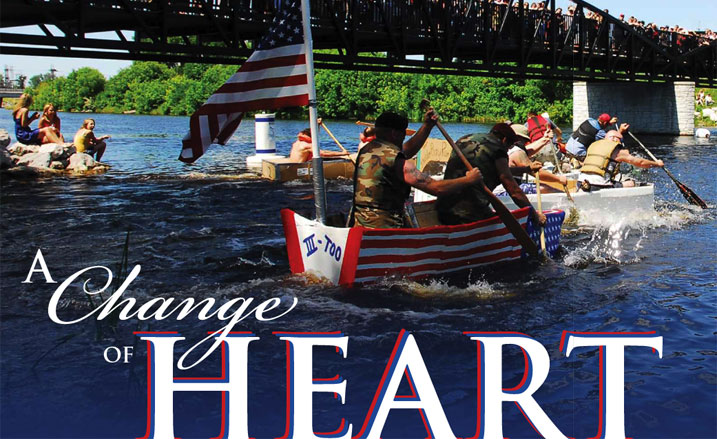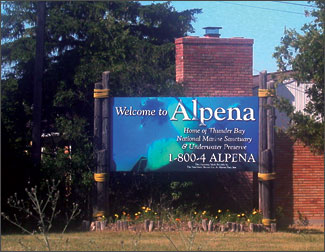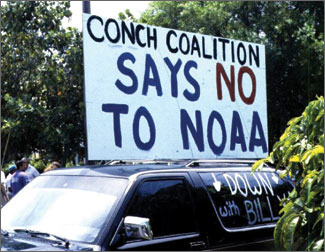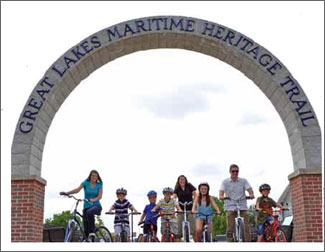




Home to some of the best preserved and historically significant shipwrecks in the United States, Thunder Bay National Marine Sanctuary is a world-class wreck diving destination, on par with places such as Scapa Flow in Scotland and Truk Lagoon in Micronesia.

Click here to check out Thunder Bay's wrecks.

By Matt Dozier
A banner in the tiny Alpena Regional Airport terminal trumpets the “home of Thunder Bay National Marine Sanctuary.” Locals speak glowingly about the sanctuary’s effect on the community. Yet just 15 years ago, this small Michigan town was the battleground for one of the fiercest disputes in the 40-year history of the national marine sanctuaries.
A Rocky Beginning “I got calls at my home, threatening calls at work — people called me the devil!
So many of them just hated me for what I was doing,” she recalls.
Pardike found herself the lone advocate for a marine sanctuary in a community
that resented the idea of federal government interference in the waters of Lake
Huron. “There was really no one else out there who was supporting the sanctuary,”
says Ellen Brody, who led the sanctuary designation effort for NOAA’s Office of
National Marine Sanctuaries.
Brody says the best measure of the community’s displeasure came in 1997,
when Alpena residents voted on a non-binding ballot question asking whether
they were for or against creating a national marine sanctuary in Thunder Bay.
The response was overwhelmingly negative. Out of more than 2,500 people
who cast their votes, a whopping 70 percent said they opposed the sanctuary.
It was a harsh rebuke to those who had been working for years to
protect Thunder Bay’s unique collection of remarkably well-preserved
historical shipwrecks through sanctuary designation. “Certainly, I was
frustrated,” says Brody. “The opposition was intense, but I guess the magnitude
of it was sort of surprising.”
Meanwhile, angry divers, fishermen and salvage operators wore Tshirts
and buttons bearing the slogan “Say No to NOAA” and packed
public meetings to voice their objections. Long-time dive charter operator
Steve Kroll was one of the many who spoke out against the sanctuary.
He says he and others were concerned that increased government control
would lead to restricted access to Thunder Bay’s shipwrecks.
“We’d been diving these wrecks for years,” Kroll says. “We didn’t want
[NOAA] telling us we couldn’t dive the wrecks, and we didn’t want to be
charged fees to dive them.”
Conflict in the Keys Bad blood swirled around the creation of Florida Keys National Marine
Sanctuary in 1990, which combined two existing sanctuaries — Looe Key
and Key Largo — into a much larger protected area that encompassed the
entirety of Florida Keys waters. From the beginning, the designation process
was plagued by bitter disputes and accusations of deception from both sides.
Opponents of the sanctuary called it a federal “power grab” and said
NOAA had no intention of keeping its promises. Sanctuary advocates
shot back, alleging that the anti-NOAA activists in the Keys were funded
and staffed by outside interests. Billy Causey, the first superintendent of
the sanctuary, was even hung in effigy by a group of irate protestors who
called themselves the “Conch Coalition.”
“That was a tough time,” Causey says. “It got to be pretty ugly.”
Bill Kelly, now the executive director of the Florida Keys Commercial
Fishing Association, saw the battle unfolding around Florida Keys
National Marine Sanctuary’s designation in 1990. “The Keys were livid,”
Kelly recalls. “Things like government control and law enforcement intervention
were deeply resented at the time.”
It’s no coincidence that the same sentiments were echoed in Alpena
later in the decade, Brody says. Many Michigan residents knew about the
Keys struggle from spending winters in Florida, and the Conch Coalition
even took out an anti-sanctuary ad in the Alpena newspaper. Despite the
vocal opposition, however, the efforts of Deb Pardike and others to rally
community support eventually paid off, and Thunder Bay National Marine
Sanctuary was designated in October 2000.
From Cynic to Supporter “It’s very important that you understand that originally I was against
establishment of the sanctuary,” Kroll’s testimony began. “I believed having
the federal government determine what we should do with our resources
would lead to too many restrictions. This attitude was shared by
many citizens and expressed at public hearings prior to designation.”
But instead of criticizing the assembled members of Congress and
NOAA leaders for imposing unwanted bureaucracy on the people of
Michigan, Kroll went on to paint a radically different picture of the sanctuary:
“The sanctuary has proven itself as a trusted partner, not just with
the state of Michigan, but also with the local community. I’ve been involved
in the process and can assure you it’s real and working.”
So, what changed? It began with the sanctuary advisory council, which
was created to give divers, fishermen, boaters and other user groups a voice in
the sanctuary’s management. Kroll, who has served on the council as a diving
representative and council chair, describes a process of open communication
and compromise that helped the sanctuary earn the trust of the local community.
“It allowed people to have their voice and see over the course of time that their input matters,” he says. “That’s the way you get ownership.”
The other element, Kroll says, was education. “The sanctuary is helping
bring maritime heritage back into schools, taking kids out on the water,”
he says. “Along this whole northeastern shore of Michigan, people who
live here are reconnecting to their past.”
Changing Minds, Producing Results “I can wear a sanctuary shirt to the grocery store now,” jokes Deputy
Superintendent Mary Tagliareni. At one time, Tagliareni says, she hesitated
to advertise her NOAA affiliation for fear of being stopped by a
disgruntled resident looking for an argument.
Bill Kelly, who as a lifelong fisherman had initial doubts about the motives
behind the Florida Keys sanctuary, says those doubts were quickly
erased by his interactions with sanctuary staff. In people like Causey and
Tagliareni, Kelly says he saw like-minded individuals working toward a
goal they shared in common: ensuring the future health of Florida’s ocean
ecosystems. And indeed, over the past two decades the Florida
Keys have seen major strides in ocean management
and conservation that benefit both local communities
and the marine environment.
“It’s so much to our benefit to preserve
these places,” Kelly says. “It’s far better to have cooperative
management than to always be at each other’s throats.”
In Alpena, the Thunder Bay sanctuary is now a
hub of education, science and tourism for an
area that has suffered decades of economic
downturn. The sanctuary is a valued partner
in the community, one that works to protect
Thunder Bay’s marine resources but also to
link local residents with their heritage and restore a sense of pride in the community.
“The community as a whole has embraced the sanctuary,” Pardike says.
“Local people aren’t just supporters of the sanctuary; they’ve become stewards.”
Building a Better Future With former opponents of the sanctuaries now some of
their most fervent supporters, places like Alpena and the Florida
Keys are now among our nation’s best hopes in turning the
tide of ocean conservation for the better.
Deb Pardike, executive director of the Alpena Convention and Visitors Bureau,
has lived in Alpena since she was 11 years old. She has made it her life’s
work to promote the city and help preserve its heritage, but when she stood up for
the designation of Thunder Bay National Marine Sanctuary in 1997, her fellow
citizens turned against her.
Alpena’s “Say No to NOAA” attitude was far from a new response to
sanctuary designation. In fact, the slogan had first cropped up nearly a
decade earlier, some 1,400 miles south of Alpena on the sunny shores of
the Florida Keys.
Twelve years later, Steve Kroll stood before the House Subcommittee
on Fisheries, Wildlife and Oceans, and prepared to testify on a proposal
to expand the Thunder Bay sanctuary boundaries from 448 square miles
to more than 4,000 square miles.
 The sanctuary is helping
bring maritime heritage back into schools, taking kids out on the water.
The sanctuary is helping
bring maritime heritage back into schools, taking kids out on the water.
Visit either of these communities today and you will see a very different
relationship between the two sanctuaries and local residents than
in the early days of their designation. Gone are the “Say No to NOAA”
signs. The dialogue at public meetings is civil rather than confrontational.
Sanctuary staff are treated as peers instead of pariahs.
Gaining the support of the public is a positive
step for these sanctuaries and others that have experienced similar turnarounds, but it is
only one step. Going forward, Causey says, the sanctuaries have a responsibility
to work with their stakeholders to achieve their mutual goals.
“One of the most important things is to not lose the connection
with the community,” he says. “You can never take that
for granted.”